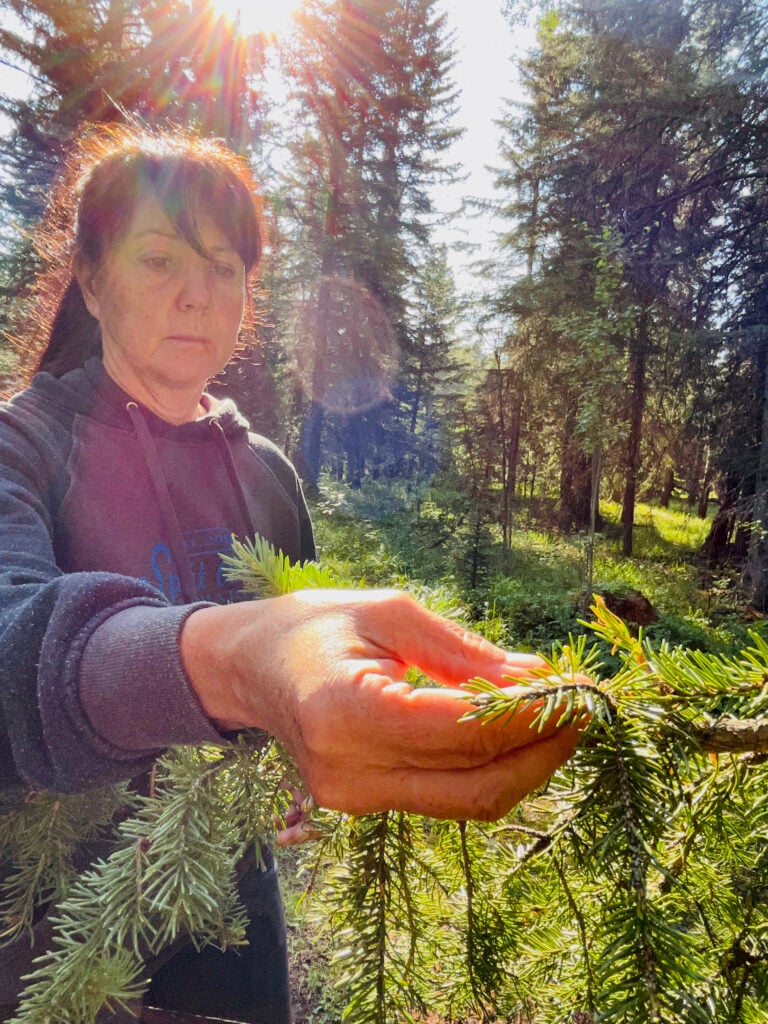
Environment
Inside the fight to protect the Arctic’s “Water Heart”
How the Sahtuto’ine Dene of Déline created the Tsá Tué Biosphere Reserve, the world’s first such UNESCO site managed by an Indigenous community
- 1693 words
- 7 minutes
Travel
Located in the foothills of the Rockies, this Indigenous experience invites you to engage with Indigenous outdoor traditions and reconnect with nature in a new way

I sit around a campfire, watching spruce logs burn, doing what one does when the world stops for half a minute. When the phone stops ringing, when emails don’t avalanche, and there’s nothing to do but sit, think, and talk. Aspens tremble in the breeze, wood crackles, and birds form a choir. The campfire topic: what does it mean to have an Indigenous experience? To connect with our home on native land.

Growth in the Indigenous tourism sector has outpaced overall Canadian tourism activity, attracting foreign and local visitors to diverse activities and destinations across the country. There are heritage parks and powwow events, fishing lodges, protected historical sites and busy urban art galleries. And then there is Painted Warriors, an 82-acre ranch located in the rolling foothills of the Rocky Mountains.
Tracey Klettl, owner and operator of Painted Warriors, shows me how to nock my arrow, clipping it to the line of my compound bow and resting it in the beautifully-named whisker biscuit. Familiarizing myself with the sport of archery reminds me of golf: success comes down to gear, technique, practice and mental acuity. Tracey patiently explains that the dominant eye is more important in marksmanship than the dominant hand. It turns out I’ve been aiming incorrectly all my life, relying on the wrong eye as I’m right-handed but left-eyed. Switching my bow to the opposite hand, she advises me to loosen my grip and compress my shoulder blades. Now I’m able to fire the arrow relatively straight, but I’ll need a lot of practice before I’ll be able to score points on the life-size animal targets.
Tracey’s partner, Tim Mearns, pulls out his large compound bow and proceeds to peg the tiny head of a golf tee from over fifty yards away. If zombies attack or I ever have to hunt for my food, I really hope I’m with Tracey and Tim. Not only are they certified hunting, archery, outdoor skills and horse-riding coaches, they’re competitive archery champions too.

“Technology really comes between us and the natural world,” says Tracey, peering into the fire. Adds Tim, nursing a cup of coffee, “If you take your shoes and socks off and stand on the earth, you can feel a charge.” Painted Warriors was initially founded as a training facility to educate and certify guides for trail riding, hunting, and outdoor adventures. The couple also felt it was crucial to approach their training exercises through an Indigenous lens. Tracey is of Cree and Mohawk descent from the area that is now Jasper National Park. Tim is Saulteaux and a member of the Cote First Nations in Saskatchewan. Proud and knowledgeable of their heritage, they invited groups of Indigenous kids and adults to the farm, many of whom have lost touch with outdoor skills and the spiritual component accompanying them. They tell me about the significance of smudging, laying tobacco, honouring harvested animals, and using all parts of the animal to respect their sacrifice. They also invite my questions and curiosity. What is the story behind the large elk head mounted above the door in the gift shop? Do you stalk or ambush animals on the bow hunt? Where is an ethical kill shot, and why is it so important?
With six large canvas tents open year-round, Painted Warriors quickly realized the potential to offer a range of experiences beyond guide training. Guests now visit from around the world, engaging their senses through half-day interpretative forest walks, horseback riding (from introductory rides to a ten-day Horseback Adventure), archery, winter snowshoe experiences, and craft workshops. Infused throughout are the traditions, stories and customs of their Cree, Ojibway and Metis culture.
Walking in the forest, Tracey explains how white powder on aspen trees functions as a compass and also an effective sunblock (good for SPV-15). She reveals how her grandmother used wild strawberries to treat upset stomachs and wild roses for eye infections. Every plant has a use, and even weeds like plantago can be chewed up and used to treat wasp stings.

“There are no weeds in Indigenous culture,” explains Tracey, who credits her sister Brenda as being the knowledge keeper in the family. Brenda offers Medicine Walks in Banff and Sundre through her own outfit, Mahikan Trails.
With their warmth, honesty, hospitality and humour, Painted Warriors provides an opportunity to approach and engage with Indigenous People, culture and traditions in a beautiful environment and in an inviting, safe space. We all come from different backgrounds and anchor ourselves with different opinions. Yet different cultures have so much more in common than we possibly imagine. We all want to be safe, inspired and content. We all want the best for our children and to do right the right thing. Take it from someone who’s visited more than 100 countries and chatted with locals from Albania to Zanzibar: it’s the people you meet who create the paradise you find. Beyond the fun activities on offer, Painted Warriors invites you into a quiet forest to sit around the campfire, share your stories, feast over a flame, and connect across cultures.
Are you passionate about Canadian geography?
You can support Canadian Geographic in 3 ways:

Environment
How the Sahtuto’ine Dene of Déline created the Tsá Tué Biosphere Reserve, the world’s first such UNESCO site managed by an Indigenous community

People & Culture
The Charter goals and Indigenous people living in Canada

People & Culture
Indigenous knowledge allowed ecosystems to thrive for millennia — and now it’s finally being recognized as integral in solving the world’s biodiversity crisis. What part did it play in COP15?

History
A look back at the early years of the 350-year-old institution that once claimed a vast portion of the globe